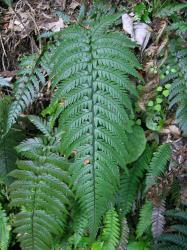Terrestrial or climbing (NZ) or epiphytic (not NZ) ferns. Evergreen or deciduous. Rhizomes erect or long-creeping, bearing non-clathrate scales. Fronds monomorphic (NZ) or dimorphic (not NZ), not articulated to rhizome. Laminae 1–5-pinnate, anadromous or catadromous, herbaceous or coriaceous, scaly and/or hairy. Veins free or rarely reticulate. Sori round, superficial, borne on abaxial surface, usually away from the margins (NZ), or acrostichoid (not NZ); paraphyses absent; indusia round or reniform, peltate, or rarely absent; sporangial maturation mixed. Sporangia with vertical annulus, 16–64 spores per sporangium. Homosporous; spores monolete, lacking chlorophyll; perispores rugose, tuberculate or cristate, sometimes fenestrate, reticulate or echinate.
A family of three subfamilies, 26 genera and c. 2115 species (PPG 1 2016).
The family Dryopteridaceae, or sometimes Aspidiaceae (e.g. Pichi Sermolli 1977), has been variously circumscribed. Kramer (1990) included Woodsiaceae (including Athyriaceae), Tectariaceae and Onocleaceae within a much broader Dryopteridaceae, but these are now all recognised as separate families (PPG 1 2016). Smith et al. (2006) retained Hypodematiaceae within their more narrowly circumscribed Dryopteridaceae, but this is now also treated as a separate family by PPG 1 (2016).
Three subfamilies were recognised within Dryopteridaceae (PPG 1 2016): Polybotryoideae, Elaphoglossoideae and Dryopteridoideae. All are monophyletic (Liu et al. 2016), but only the latter two occur in New Zealand, with Lastreopsis, Parapolystichum and Rumohra in Elaphoglossoideae, and Arachniodes, Cyrtomium, Dryopteris and Polystichum in Dryopteridoideae.
Within Elaphoglossoideae, the lastreopsid ferns form a well-supported clade comprising Rumohra, Megalastrum, Lastreopsis sens. str. and Parapolystichum (Labiak et al. 2014; Gardner et al. 2017). However, although the monophyly of the lastreopsid ferns is strongly supported by molecular data, Labiak et al. (2014, 2015) found no morphological synapomorphies that distinguish these ferns from other clades within the Dryopteridaceae. Nevertheless, they noted that the lastreopsids, apart from Megalastrum, can usually be diagnosed by their distinctive rachis-costa architecture, in which the marginal ridge of the lamina is confluent with the walls of the rachis. Other characters, such as the deltoid and highly dissected laminae, creeping rhizomes, round sori, and presence of yellow or orange glands, occur in most, but not all, representatives of the group.
The individual clades comprising Rumohra, Megalastrum, Lastreopsis sens. str. and Parapolystichum are also monophyletic, although the Lastreopsis clade is only weakly supported by molecular data. As with the larger lastreopsid clade, there are no clear morphological synapomorphies that define either Lastreopsis sens. str. or Parapolystichum. On the other hand, the genus Lastreopsis sens. lat., as defined by Tindale (1965) to encompass most of the species currently assigned to Lastreopsis sens. str. and Parapolystichum, is paraphyletic according to the analyses of Labiak et al. (2014) and Gardner et al. (2017). This leaves an uncomfortable choice between adopting a single monophyletic but morphologically unrecognisable genus for all lastreopsid ferns, a set of four monophyletic genera of which Lastreopsis sens. str. and Parapolystichum are not always morphologically recognisable, or retaining Lastreopsis sens. lat., which is paraphyletic. In our opinion, the least unsatisfactory of these options is to accept the four genera, Rumohra, Megalastrum, Lastreopsis sens. str. and Parapolystichum, as proposed by Labiak et al. (2014, 2015) and Gardner et al. (2017), albeit noting that the latter two cannot always be recognised in the field.
| 1 | Fertile laminae 1-pinnate; primary pinnae toothed but not divided more than ½ way to midrib | 2 |
| Fertile laminae 1-pinnate-pinnatisect to 4-pinnate; if 1-pinnate, primary pinnae divided more than ½ way to midrib | 3 | |
| 2 | Veins reticulate; indusia round | Cyrtomium |
| Veins free; indusia reniform | Dryopteris | |
| 3 | Indusia round or absent | 4 |
| Indusia reniform | 5 | |
| 4 | Rhizomes erect; ultimate lamina segments usually acute, acuminate or mucronate; laminae sometimes bulbiferous | Polystichum |
| Rhizomes long-creeping; ultimate lamina segments obtuse or round-ended; laminae never bulbiferous | Rumohra | |
| 5 | Laminae bearing hairs and scales | 6 |
| Laminae bearing scales, but lacking hairs | 8 | |
| 6 | Stipes and rachises bearing bristle-like scales with bulbous bases | Lastreopsis |
| Stipes and rachises bearing non-bristle-like scales without bulbous bases | 7 | |
| 7 | Stipes, rachises and laminae densely covered in soft brown hairs on both surfaces; laminae with a velvety feel | Lastreopsis |
| Stipes, rachises and laminae bearing red or whitish hairs, often sparse on abaxial surfaces; laminae soft but not velvety | Parapolystichum | |
| 8 | Rhizomes long-creeping; plants confined to the Kermadec Islands | Arachniodes |
| Rhizomes erect or short-creeping; plants of the main islands of New Zealand | Dryopteris |
Dryopteridaceae is a large and diverse family comprising mainly terrestrial species with erect rhizomes, although a few species have long-creeping rhizomes. The fronds are monomorphic, usually 2–5-pinnate (but rarely only 1-pinnate), abundantly scaly and sometimes also hairy. Some species are bulbiferous, and the naturalised species are often deciduous. The veins are usually free, except in Cyrtomium. The sori are round, protected by round or reniform, peltate indusia, or occasionally exindusiate. The spores are monolete with prominent perispores (Large & Braggins 1991), and the base chromosome number is x = 41.
Dryopteridaceae is a large family, cosmopolitan in distribution, with its greatest diversity in north temperate regions, and in montane regions of central, eastern and southern Asia (Kramer 1990). Five non-endemic and two naturalised genera, with 30 species in New Zealand: nine endemic, four non-endemic, and 17 naturalised or casual species.
| Category | Number |
|---|---|
| Indigenous (Endemic) | 8 |
| Indigenous (Non-endemic) | 5 |
| Exotic: Fully Naturalised | 7 |
| Exotic: Casual | 10 |
| Total | 30 |
Incertae sedis
The type for the following name has not been located and its identity is uncertain:
Aspidium coriaceum var. acutidentatum A.Rich., Voy. Astrolabe, Essai, 71 (1832)




